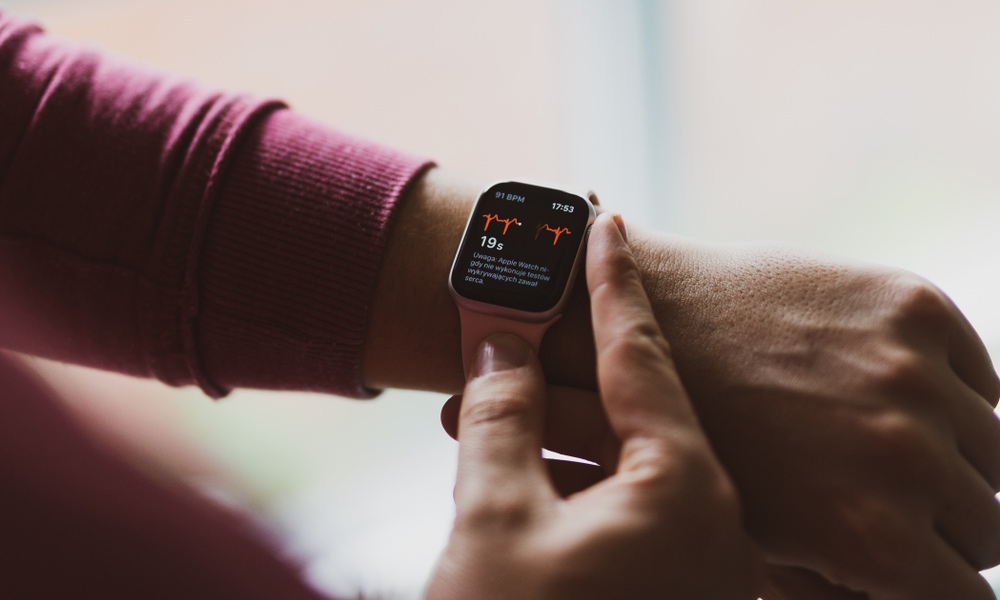PSA | Asymptomatic Heart Disease Can Be Detected with an Apple Watch, New Study Shows
 Credit: guteksk7 / Shutterstock
Credit: guteksk7 / Shutterstock
Toggle Dark Mode
The real magic of the Apple Watch as a health device isn’t in the raw data that comes from its sensors but rather the algorithms that interpret and draw conclusions from that data.
It’s the challenges in developing these algorithms properly that hold back features like body temperature and blood pressure sensors, but Apple isn’t the only one working on these problems. The entire health care industry is looking for better ways to diagnose health conditions that often fly under the radar.
It was this very problem that prompted Apple to add an ECG and irregular heart rhythm notifications to the Apple Watch Series 4 in 2018, leading many folks to discover that they were suffering from atrial fibrillation (Afib) — a common heart condition that occurs intermittently and can therefore go undetected for years.
It’s something that an Apple Watch is much less likely to miss since, unlike the diagnostic equipment at your local health care facility, most people wear their watch for several hours a day, every day.
Now, researchers at the Mayo Clinic are taking this to the next level. They’re leveraging a sophisticated artificial intelligence (AI) algorithm they’ve developed to help detect patients with a weak heart pump using data from the Apple Watch ECG app.
Although atrial fibrillation is relatively easy to detect when it’s actually happening, discovering a weak heart pump — clinically known as left ventricular dysfunction — typically requires considerably more in-depth testing.
According to Dr. Paul Friedman, who chairs the Department of Cardiovascular Medicine at the Mayo Clinic in Rochester, New York, the condition afflicts 2–3 percent of people globally across all age groups and up to 9 percent of people over age 60.
It’s also a condition that usually carries no apparent symptoms. Some may experience shortness of breath, leg swelling, or racing heartbeats, Dr. Friedman says, while others have no idea at all that they’re suffering from this potentially life-threatening condition.
What’s even more unfortunate is that it’s eminently treatable, but of course, doctors have to know the condition exists before they can treat it. This is where the Apple Watch comes in.
It is absolutely remarkable that AI transforms a consumer watch ECG signal into a detector of this condition, which would normally require an expensive, sophisticated imaging test, such as an echocardiogram, CT scan or MRI.Dr. Paul Friedman, Chair, Mayo Clinic Department of Cardiovascular Medicine
Most people who have no heart symptoms aren’t going to get routinely hooked up to a medical-grade 12-lead ECG and certainly aren’t going for CT scans and MRIs. So, the Mayo Clinic set out to determine if they could detect a weak heart pump with nothing more than the single-lead ECG found on the Apple Watch.
The Study
A standard ECG administered in a hospital lab uses 12 electrodes placed on a person’s chest, arms, and legs to map the electrical signals from the heart. The Apple Watch ECG only has a single “lead” — the connection point on your wrist.
It’s far less sophisticated than a full ECG, and in the early days of the feature, it even left some doctors concerned about accuracy problems and misdiagnoses. However, as time has gone by, medical researchers have been looking at ways to make the best use of that data that they possibly can.
In this case, researchers at the Mayo Clinic took an established algorithm used to detect a weak heart pump in traditional 12-lead ECG systems and modified it to work with the single-lead data that comes from the Apple Watch.
The project was spearheaded by Itzhak Zachi Attia, Ph.D., the lead AI scientist in the Mayo Clinic’s Department of Cardiovascular Medicine. Dr. Attia “created an adaptation technique that translated the single-lead readings into signals understandable by the algorithm.“
Once the algorithm had been developed, it was time to put it to the test. The Mayo Clinic called upon 2,454 of the clinic’s patients to volunteer to participate in the study.
Over six months, they securely transmitted 125,610 ECGs from the Apple Watch from 46 states and 11 countries.
On average, participants took ECG readings about twice a month, and 92 percent of those in the study used the ECG app more than once.
Approximately 420 patients had a watch ECG recorded within 30 days of a clinically ordered echocardiogram, or ultrasound of the heart, a standard test to measure pump strength. We took advantage of those data to see whether we could identify a weak heart pump with AI analysis of the watch ECG. While our data are early, the test had an area under the curve of 0.88, meaning it is as good as or slightly better than a medical treadmill test. AI analysis of the watch ECG is a powerful test to identify a weak heart pump.Dr. Itzhak Zachi Attia, Ph.D., lead scientist and co-director of Artificial Intelligence, Mayo Clinic Department of Cardiovascular Medicine
The study proved that doctors can get “medically useful information from a single-lead watch,” Dr. Friedman said. While this test was just the first step, the Mayo Clinic plans to expand the study globally “to test this prospectively in more diverse populations and demonstrate medical benefit.”
This is what the transformation of medicine looks like: inexpensively diagnosing serious disease from your sofa. Dr. Paul Friedman, Chair, Mayo Clinic Department of Cardiovascular Medicine
Participants in the study used an iPhone, the Mayo Clinic app, and an Apple Watch Series 4 or later. Patients took ECGs regularly on the Apple Watch, which the Mayo Clinic app transmitted to a secure data platform for analysis. The study was funded entirely by the Mayo Clinic. Apple did not provide any technical or financial support.







